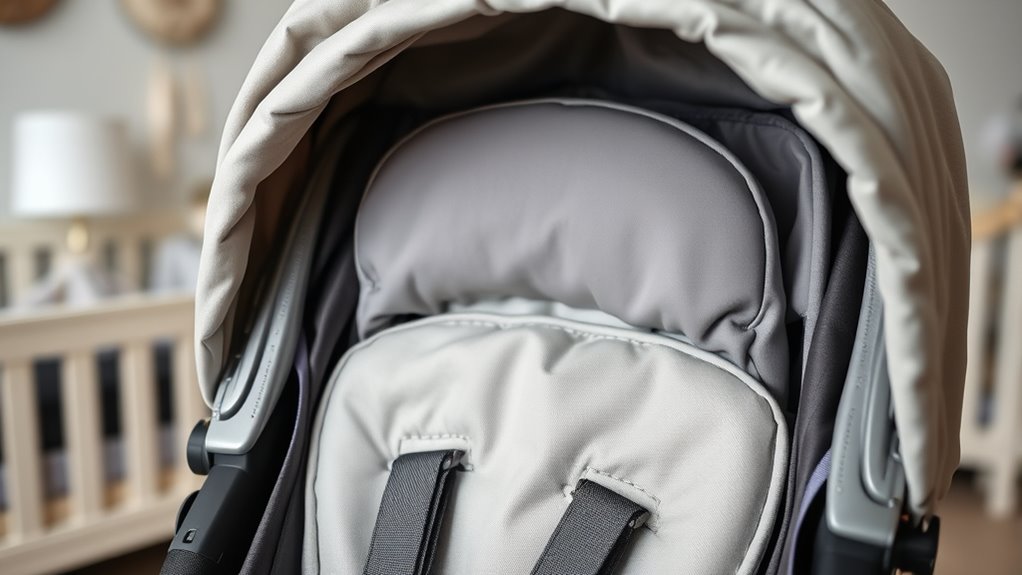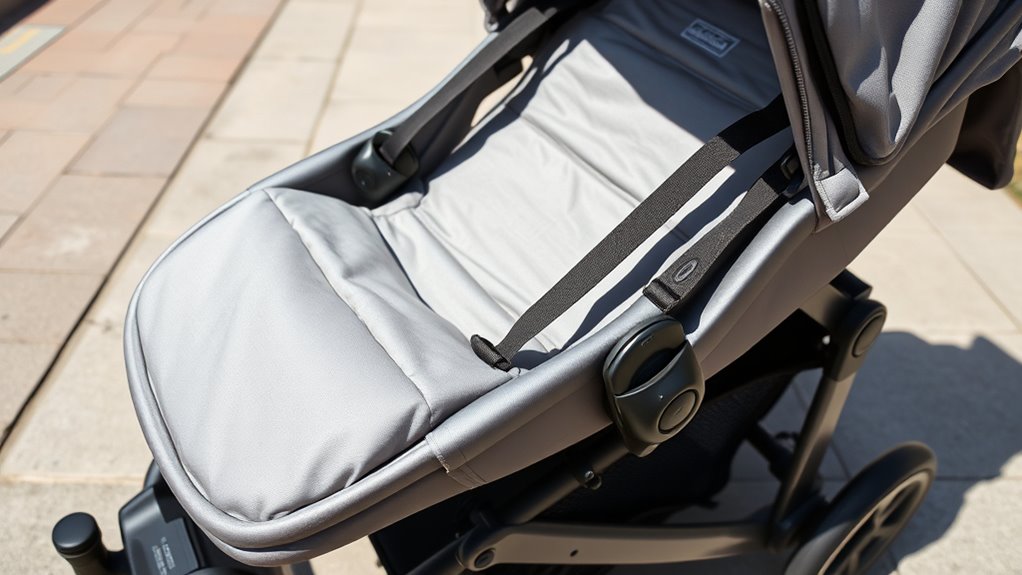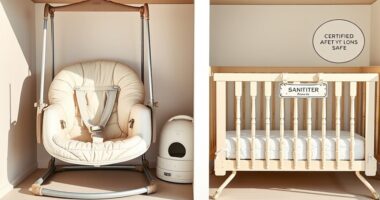If your stroller isn’t equipped to support newborns, you’ll notice clues like difficulty attaching infant car seats, a lack of full recline positions, and insufficient head and neck support. You might also find storage hard to access or the seat uncomfortable and unsafe for a newborn’s delicate needs. Safety standards and secure harnesses are often missing, increasing risks during outings. Keep an eye out for these signs to ensure your baby’s safety—more details await you.
Key Takeaways
- The stroller cannot securely hold or support an infant car seat safely.
- It lacks a fully flat recline and proper head support for newborn comfort.
- Storage compartments are small, hard to access, or unsuitable for baby essentials.
- The seat design doesn’t include adequate padding or adjustable harnesses for safety.
- The stroller doesn’t meet safety standards or lacks necessary certifications.

If you’re using a stroller that wasn’t designed specifically for newborns, you might notice some clear signs that it’s not suitable for your little one. One of the most important aspects to check is car seat compatibility. If you plan to use your stroller with a car seat, make sure it’s compatible with the model you have or plan to buy. Not all strollers are designed to securely hold infant car seats, especially those that lack proper adapters or support systems. If you find yourself struggling to attach the car seat safely or if it wobbles or feels unstable, it’s a strong indicator that the stroller isn’t intended for newborns. Using an incompatible or unapproved setup can compromise your baby’s safety, which is the last thing you want. Also, consider whether the stroller provides the necessary support for a newborn’s delicate head and neck. Many strollers that aren’t newborn-ready don’t offer a fully reclined seat position or proper head support, making it unsafe or uncomfortable for your baby during outings. A fully flat recline is essential for newborn comfort and safety. Storage convenience is another often-overlooked sign. If your stroller lacks sufficient storage space or the storage areas are hard to access when your little one is seated, it’s probably not the right choice for newborns. Babies require frequent supplies—diapers, bottles, extra clothing—and having accessible storage makes outings easier. Strollers designed for newborns typically feature larger, more accessible baskets or compartments that can hold essentials without disturbing your baby’s comfort. If you notice that the storage is cramped or awkward to reach, you might struggle to carry everything you need, which can lead to inconvenient or unsafe situations. Additionally, check the overall design of the stroller. If it doesn’t have a fully flat recline or a sturdy, supportive seat, it’s likely not suitable for a newborn. Newborns need a flat surface to lie on for proper spinal support and safety, and many strollers that aren’t newborn-ready simply don’t provide this feature. Without it, your baby might be uncomfortable or at risk of slouching into unsafe positions. Proper ergonomic support is vital for your baby’s development and comfort during outings. Furthermore, consider the additional features that enhance safety and comfort, such as adjustable harnesses and padding, which are especially important for newborns. Additionally, look for safety standards and certifications that indicate the stroller has been tested for infant safety and durability. The importance of stroller stability cannot be overstated, as a stable design helps prevent tipping and ensures safe outings.
Frequently Asked Questions
Can I Convert a Regular Stroller for Newborn Use?
You can often convert a regular stroller for newborn use with the right accessories. Look for convertible options that allow you to add a bassinet or reclining seat, ensuring your baby’s comfort and safety. Always check that the stroller has secure safety harnesses to keep your newborn safe. If your stroller isn’t designed for newborns, avoid modifications that compromise stability or safety. Prioritize your baby’s safety above all.
Are All Strollers Adjustable for Different Infant Sizes?
Imagine you’re choosing a stroller for your growing baby. Not all strollers are adjustable for different infant sizes, so check features like seat padding and canopy coverage. For example, a stroller with adjustable seat recline and removable padding guarantees comfort as your baby grows. Look for models that can adapt to your infant’s size, providing proper support and protection, making outings safer and more comfortable for your little one.
How Do I Know if My Stroller’s Harness Is Secure?
To know if your stroller’s harness is secure, first check its safety features and verify the harness adjustment is snug but comfortable around your child. You should be able to fit only two fingers between the harness and your child’s chest. Make sure all clips are fastened properly and that the straps lie flat without twists. Regularly test the harness to confirm it stays secure during movement.
What Accessories Make a Stroller More Newborn-Friendly?
To make your stroller more newborn-friendly, consider accessories like a compatible car seat that fits securely, guaranteeing safe travel from day one. You should also check the stroller’s weight limits to confirm it can support your newborn comfortably. Adding a plush padding or a cozy footmuff enhances comfort, while a sunshade or insect net provides protection. These accessories create a safer, more comfortable environment for your newborn during outings.
Is a Bassinet Attachment Necessary for Newborns?
Thinking about bassinets and baby’s comfort? A bassinet attachment isn’t strictly necessary, but it can provide a cozy, flat sleep position for your newborn. It pairs perfectly with infant car seats, offering a seamless shift from car to stroller. Without a bassinet, guarantee your stroller supports safe sleeping, with a flat, firm surface. This helps keep your little one snug, safe, and secure during strolls, making outings more enjoyable for both of you.
Conclusion
If your stroller shows any of these signs, don’t ignore them—you might be barking up the wrong tree. It’s better to wait until it’s truly ready for your newborn’s safety and comfort. Rushing into using a stroller that’s not prepared can turn your outings into a wild goose chase. Stay vigilant, and when in doubt, hold off until everything checks out. After all, a safe stroller is the key to smooth sailing with your little one.









